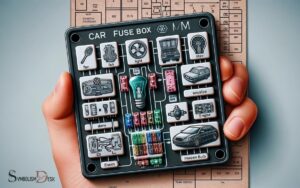What Does the Car Sliding Symbol Mean? Problem!
The car sliding symbol, commonly displayed on a vehicle’s dashboard, is the traction control or electronic stability control indicator.
It often appears as a car with skid marks and illuminates when the system is actively working to maintain traction, usually during slippery conditions. If the light stays on, it may indicate a problem with the system.
When the car sliding symbol lights up momentarily, it’s a sign that the traction control or electronic stability control system is engaged.
This technology helps to prevent the wheels from losing grip by applying brakes or reducing engine power when it detects a loss of traction. It’s particularly useful during wet, icy, or snowy conditions, or when accelerating on loose surfaces.
Here is a brief overview of what the sliding car symbol means:
The sliding car symbol serves as a prompt for drivers to proceed with caution, signaling that the vehicle’s stability systems are in operation to ensure a safer driving experience.

Key Takeaway
Understanding the Car Sliding Symbol
The car sliding symbol indicates a loss of traction. When this symbol illuminates on the dashboard, it signifies that the vehicle is experiencing a decrease in grip between the tires and the road surface.
This can occur due to various reasons such as wet or icy road conditions, excessive speed, or abrupt steering or braking actions.
It is a critical warning for the driver to exercise caution and adjust their driving behavior to regain traction and control of the vehicle. It is advisable to reduce speed, avoid sudden maneuvers, and gently apply the brakes to help regain traction.
Understanding the implications of this symbol is crucial for ensuring the safety of the driver, passengers, and other road users.
Causes of the Car Sliding Symbol
When the car sliding symbol illuminates on the dashboard, it typically indicates a loss of traction caused by factors such as wet or icy road conditions, excessive speed, or abrupt steering or braking actions.
Wet road conditions reduce tire grip, making it easier for the tires to lose traction and causing the car to slide. Similarly, icy roads significantly decrease tire traction, leading to sliding.
Excessive speed can also result in loss of traction, as the tires may not be able to maintain grip on the road surface. Abrupt steering or braking actions can disrupt the balance of the vehicle and cause loss of traction.
Understanding these causes can help drivers take preventative measures to avoid triggering the car sliding symbol and maintain safe driving conditions.
How the System Works
When facing challenging road conditions as outlined in the previous subtopic, the car’s traction control system works to prevent sliding and loss of control by actively managing the grip of each tire.
The system achieves this by utilizing various sensors and the car’s onboard computer to monitor wheel speed, throttle position, and steering angle.
Here’s how the system works:
- Sensor Data Monitoring: The traction control system constantly monitors wheel speed, comparing the rotational speed of each wheel to detect any variances.
- Throttle Intervention: If the system detects wheel spin, it can intervene by reducing engine power or applying brakes to the spinning wheel.
- Steering Angle Adjustment: The system can also adjust the vehicle’s trajectory by applying brakes to specific wheels based on the steering angle.
- Real-time Adjustment: All these actions occur in real-time, helping the system to mitigate sliding and loss of control.
- Enhanced Safety: By actively managing tire grip, the traction control system enhances safety during challenging road conditions.
Interpreting the Warning
If you see the car sliding symbol illuminate on the dashboard, you should immediately reduce your speed and proceed with caution. This warning indicates that the vehicle’s traction control system has detected a potential loss of traction, often due to slippery road conditions.
It is crucial to interpret this warning as a signal to adapt your driving behavior to the current road conditions. Slow down gradually and avoid sudden steering or braking maneuvers to regain control of the vehicle.
Additionally, be mindful of any potential hazards on the road, such as black ice or debris. If the warning persists, it is advisable to have the vehicle inspected by a qualified technician to ensure the proper functioning of the traction control system and address any underlying issues.
Responding to the Symbol
When faced with the car sliding symbol, it is crucial to understand its implications and take appropriate safety measures. Drivers should be prepared to handle slippery roadways with caution and skill. The article will now discuss these points in detail.
Understanding the Sliding Symbol
The sliding symbol on a car’s dashboard indicates a loss of traction, prompting the driver to respond with caution and corrective action. When this warning light appears, it’s crucial for the driver to understand how to react effectively to ensure safety on the road.
Here are some key steps to consider when encountering the sliding symbol:
- Stay Calm: Avoid sudden movements or overreacting, as it can worsen the situation.
- Gently Ease Off the Accelerator: Reduce speed gradually by taking your foot off the accelerator.
- Steer in the Direction of the Slide: Turn the steering wheel gently in the direction the rear of the car is sliding.
- Avoid Harsh Braking: Abrupt braking can cause further loss of control, so lightly apply the brakes if necessary.
- Regain Traction: Once traction is reestablished, gradually accelerate to stabilize the vehicle.
Safety Measures to Take
In response to the sliding symbol on the dashboard, drivers should prioritize safety by implementing specific measures to regain control of the vehicle. First, it is crucial to remain calm and avoid sudden movements.
Drivers should gently ease off the accelerator to reduce speed and regain traction. Steering inputs should be smooth and gradual, allowing the vehicle to regain stability.
Engaging the brakes should be done cautiously, avoiding sudden or hard braking that could further destabilize the vehicle. It’s important to focus on the intended direction of travel and steer in that direction.
Additionally, it is advisable to maintain a safe distance from other vehicles to allow for ample reaction time. These safety measures can help drivers effectively respond to the sliding symbol on the dashboard and regain control of the vehicle.
Handling Slippery Roadways
Transitioning from the safety measures to take when facing the sliding symbol on the dashboard, drivers should now understand how to effectively handle slippery roadways in response to this symbol.
When encountering the sliding symbol, it’s crucial to adjust driving behavior to ensure safety.
Here are key steps to respond to the symbol:
- Reduce Speed: Slow down to gain better traction.
- Increase Following Distance: Allow for more space between vehicles to accommodate longer stopping distances.
- Avoid Sudden Movements: Steer, accelerate, and brake gradually to prevent skidding.
- Use Lower Gears: When driving a manual transmission, use lower gears to improve control.
- Consider Winter Tires: Equipping the vehicle with winter tires can significantly enhance traction on slippery surfaces.
Importance of Traction Control
Traction control becomes crucial when driving in slippery conditions, such as rain or snow. This system helps to prevent the wheels from spinning excessively when accelerating, thereby maintaining traction with the road surface.
By modulating the power delivery to the wheels, traction control assists in preventing skidding and loss of control, especially on slick surfaces.
It achieves this by using sensors to monitor wheel speed and making adjustments to the engine power or applying the brakes as needed. Traction control is particularly beneficial in maintaining vehicle stability and reducing the risk of accidents in adverse weather conditions.
Drivers can rely on this feature to enhance their safety and confidence when driving in challenging environments.
Common Misconceptions
Many drivers believe that traction control only benefits them in icy conditions, but it actually provides assistance in various slippery situations. Contrary to popular misconceptions, traction control offers significant advantages beyond just icy roads.
Here are some common misconceptions about traction control:
- Traction control is only useful in winter weather.
- Traction control is unnecessary for vehicles with all-wheel drive.
- Traction control impedes the vehicle’s performance.
- Traction control is not essential for experienced drivers.
- Traction control only activates when the road is extremely slippery.
Understanding the true capabilities of traction control will help drivers make the most of this valuable safety feature in a wide range of driving conditions.
Seeking Professional Assistance
When encountering issues with the car sliding symbol, seeking professional assistance is crucial. Trusting trained mechanics can provide expert advice and guidance on how to address the problem effectively.
It is imperative to consult with professionals to ensure the car’s safety and proper functioning.
Expert Advice Crucial
Seeking professional assistance is crucial when interpreting the car sliding symbol. This is a complex indicator that requires expert analysis to understand its implications accurately.
Here are some reasons why seeking expert advice is crucial:
- Interpretation Complexity: The car sliding symbol can have various meanings based on the context and the vehicle’s specific features.
- Safety Implications: Understanding the symbol’s significance is vital for ensuring the vehicle’s safety and performance.
- Technical Expertise: Professionals possess the technical knowledge and experience to accurately decipher the symbol’s implications.
- Preventive Maintenance: Expert advice can help in identifying potential issues early, preventing costly repairs in the future.
- Optimal Performance: Professional input can contribute to maintaining the vehicle’s optimal functionality and safety.
Transitioning into the subsequent section about ‘trust trained mechanics’, it is equally important to rely on trained mechanics for addressing any issues identified through professional interpretation.
Trust Trained Mechanics
To ensure accurate diagnosis and resolution of issues related to the car sliding symbol, it’s essential to rely on trained mechanics with expertise in interpreting vehicle indicators.
Professional assistance is crucial as it ensures that the root cause of the sliding symbol appearing is correctly identified.
Trained mechanics have the knowledge and experience to perform thorough inspections, using specialized diagnostic equipment to pinpoint the exact issue.
Their expertise enables them to differentiate between potential causes such as traction control system malfunctions, ABS issues, or problems with the vehicle stability control system.
Additionally, they can provide the necessary repairs or adjustments with precision, restoring the vehicle’s safety and performance. Trusting trained mechanics for assistance with the car sliding symbol not only ensures accurate diagnosis but also promotes driving safety and peace of mind.
Conclusion
Understanding the car sliding symbol is crucial for safe driving. It’s like having a compass in a storm, guiding drivers through slippery conditions.
By knowing the causes, how the system works, and how to respond, drivers can navigate hazardous situations with confidence.
Traction control is a vital tool in preventing accidents, and seeking professional assistance can ensure the system is functioning properly for maximum safety.







